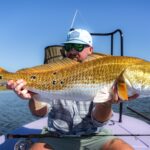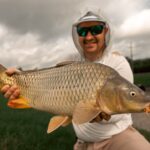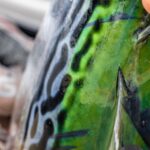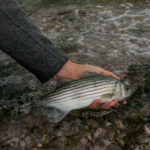
Louisiana Bull Reds Up for Harvest Again: H.B. 604 Must Not Pass
Photo Credit: Carter Abramson | Trevor Johnson Every now and then, we encounter something so
As the fishing community grapples with the future of striped bass, a sobering reality persists: the species now faces six consecutive years of failed spawning. Maryland’s Department of Natural Resources (DNR) just released the 2024 Juvenile Abundance Index. The result: a 2.0, well below the 11.0 average, painting a grim outlook for the most iconic fish on the East Coast. This news is earth shattering for a fishery that traditionally has a prolific spawn every 4-5 years. There is no “magic new place” where stripers are spawning. Not further north in the lesser-producing tributaries, or offshore in the canyons. Sure, some anglers and guides enjoyed decent fishing this year in different parts of the coast. Those hot pockets for action don’t change the fact that the striper situation on a coast-wide level is about to get very real. Six straight years of poor spawns means we do not have new fish on the way for a very long time. We must not forget that these fish are managed as a coast-wide resource for all sectors, and to be available for stakeholders of all means, from jetties and piers to center consoles.

The latest stock assessment indicates that the spawning stock biomass (SSB) of striped bass is unlikely to recover easily after enduring six years of poor recruitment. Since 2010, the SSB has faced significant pressures, resulting in dramatically reduced numbers of young fish entering the population. The 2022 assessment revealed that while some years showed promise, the subsequent years have seen age-1 fish populations fall below long-term averages
Notably, the spike in recreational removals by instituting a slot that targeted the robust 2015-year class in 2022—up by 38% from the previous year—exemplifies the unsustainable fishing practices that have contributed to this decline. Abundance drives effort.
Stripers spawn in waves and each wave consists of a certain size class of fish. The largest fish spawn in the first wave and each consecutive wave consists of a smaller class. Striped bass spawn in this way to maximize the potential to hit the right conditions. What happens if there are holes in the age structure? We don’t have a lot of very large fish left. Not having a stratified population is minimizing spawning potential. It is like playing 5 card draw with 3 cards. You aren’t going to win many hands. We know this, and managers know this as well, but they try to place the blame on everything but this fact.
Understanding the dynamics of striped bass populations requires recognizing the crucial role of the Chesapeake Bay, where a significant portion of adult striped bass are born. Recent DNA studies have confirmed that most of these fish originate from this vital estuary, underscoring the Bay’s importance not just locally, but for the entire Atlantic striped bass population.
The commercial quotas are staggering in the Chesapeake. The Potomac River has almost the same quota as the entire state of Massachusetts. How can we continue down this path knowing there are 6 consecutive spawning failures? Recreational harvest and effort hit rock bottom in the Maryland portion of the bay. This isn’t because of regulation. It is because there are no fish to catch. Yet, the commercial fishery continues unabated.
As we face “lean times” for striped bass in the ocean, protecting large spawning age fish is essential for the long-term viability of this species.
Maryland DNR’s announcement regarding the striped bass JAI should guide the path forward. While the scientists are having issues projecting recovery, we have very real data that shows how bad things are getting.
Now is the time for action. Every individual has a role to play in the conservation of striped bass. Attend the upcoming meetings, share your insights, and advocate for change.
The sixth bad spawn in a row has placed the spotlight on the ASMFC Striped Bass Board meeting on the 23rd. We are humbled by everyone’s support for our latest Call for Critical Action. The Official ASGA Letter was submitted and included in the upcoming meeting Supplemental Materials. Over 1500 individuals and 200 businesses representing millions of dollars of annual industry showed their commitment to rebuilding this stock. If this management body can’t see the writing on the wall, then they should not be managing this fishery…

Photo Credit: Carter Abramson | Trevor Johnson Every now and then, we encounter something so

This past weekend, ASGA proudly sponsored the Dirty Carp Tournament in Louisiana — and no, you didn’t misread that.

After years of data pouring in from The Albie Project, advocacy, persistence, and support from

This morning, the Connecticut Environment Committee held a hearing on House Bill 6248, a bill
We rely on our members and donations to keep fighting for a sustainable tomorrow in marine conservation.
GIVE THE GIFT OF FISHERIES CONSERVATION THIS HOLIDAY SEASON. SHOP ASGA GOODS THAT FUND FISHERIES RESEARCH & ADVOCACY CAMPAIGNS
JOIN ASGA IN CALLING FOR CRITICAL MANAGEMENT ACTION AFTER YEARS OF SPAWN FAILURES & POOR MANAGEMENT.
By using this website, you agree to our use of cookies. We use cookies to provide you with a great experience and to help our website run effectively. To learn more, please review our privacy policy.
8 Responses
This is so disheartening to read. Been preaching for years for a moratorium. If it doesn’t happen now, we won’t need it because the stripers will be gone forever. There is no other option. Make illegal to harvest for everyone fishing for them, period. This is the solution that worked in the 80’s and will be the solution to work again, it just needs to be implemented. 5 year’s minimum, 10 years would be amazing.
Thanks for calling attention to the challenges faced by striped bass on the Atlantic coast. I would raise a few additional points for consideration.
In the linked article from MD DNR is a second link summarizing previously published work on the disconnect between the striped bass spawn and recent winter conditions. To summarize, just hatched striped bass larvae depend on zooplankton for food. A dominant zooplankton source they depend on are cold weather copepods. If the copepods bloom before the striped bass need them, there is a disconnect that impacts success of the striped bass spawn.
So while you are right to mention waves of striped bass spawners in an average year, if the largest fish come first, even they might have missed an opportunity to contribute to a strong year class.
And while we should rightly do everything possible to protect our spawning stock, compared to conditions that existed on the 1980’s, there remains adequate striped bass spawning stock to produce a good or even dominant year. So, while important, evidence suggests it is not predominantly the fisheries impacts leading to our current situation. The strongest correlation is to warm winters.
That’s why, yes, we should hold ourselves and fishery managers accountable, if only to hold out hope for better future winter conditions. But we also need to be focusing greater attention on climate impacts to fish and our fishing access. For striped bass, long term trends suggest fewer and fewer of those winters in our future.
On a related note, I recently read the recent publication from a group of recreational angler organizations, including ASA, listing priority recommendations for the next administration. I was surprised to see only a passing mention of climate. That feels like a huge missed opportunity.
Whether you pursue striped bass on the east coast, trout out west or myriad species anywhere else, conditions are changing. And generally not for the better. I hope ASA and other leading organizations can at least begin to acknowledge that fact. Otherwise we are fighting skirmishes while the real battle rages elsewhere.
Thanks for your time.
Eric, you should note that our logo wasn’t on that letter. We would love to be in a position to worry about issues that have 50 year solutions. However, because we represent people and not amorphous ideas, we have to worry about next year. ASMFC doesn’t manage climate change. They barely manage striped bass.
Quick follow up? Did climate change start in 2019? Because here are the year classes… 2011 YOY 4th best, 2015 YOY 8th best, 2017 and 2018 YOY slightly above avg.
Sorry, did not mean to group you in with the authors of the priorities document. And there is no question we should protect the spawning stock while we both hope for better environmental conditions and also look for alternative explanations.
And I am worried about next year too. I see the same things you guys see on the Bay. But I am more worried about access and opportunity for future generations and the need to work on the right things.
Climate conditions are trending warmer over a long time. That’s hardly an amorphous idea. So are ocean temps. And longer term trends simply change the odds for or against various annual outcomes. (Not dissimilar to a successful spawn).
My fundamental points are that 1) in the case of SB the most plausible current correlation is to winter weather conditions, and, 2) from a bigger picture perspective fishing interests would be well advised to get more engaged on climate issues.
Did climate change start in 2019 when spawns began to fail? We have testified on climate at the senate. We have pushed the issue at every council. We have been on every call and in every discussion. This is not a climate issue. It isn’t pollution. It isn’t water quality. It isn’t sun spots, ufo’s, a gopher uprising in Utah, or bigfoot. We overfished for 21 of the last 24 years. Every time the wind blows, it is not a climate crisis. Climate activists would do much better if they didn’t apply this to each and every issue. It takes away from what we can do. I’m sorry if you don’t see that.
I honestly hope you are right. In any case, I hope you know I respect your work. Keep up the good fight.
Can we hatchery raise striped bass fingerlings to increase the biomass? Higher water temperatures, low water flows due to dry conditions, silting covering eggs, and predation of eggs and fry are all suspected of contributing to low young of the year.
Would hatchery raising to fingerlings overcome some of the above causes? Just fingerling size to get past the egg and fry stage.
Isn’t Virginia already hatchery raising striped bass but using them only in freshwater? Not hybrid stripers but full striped bass. See the link below to an older article on Virginia hatchery raising which discusses the program and does not appear to be talking about hybrids.
Instead of just reducing the number of fish taken, can we increase the number of fish that make it to fingerling stage. https://www.westernbass.com/article/spawning-and-stocking-program-striped-bass
Tom, they are stocking these fish in lakes. We are 100% opposed to stocking in the ocean. It will not help the population. It will create a false sense that everything is OK. SC stocks over a million redfish a year. The southern redfish stock in the Atlantic is collapsing. That is based on the most recent stock assessment which was released last week. A 67% reduction in harvest is needed to get the stock back up to acceptable levels.
TX stocks between ten to twenty million redfish a year. Less than 5% (more like 2%) make it to the adult population. They know this through DNA work. Age one stripers are measured in the hundreds of millions. They could fire up every hatchery on the East Coast and it wouldn’t make a dent. Hatcheries are expensive boondoggles that do absolutely nothing to restore a stock. In most cases, they are a detriment to the native fish making survival even more difficult. We have discussed this extensively on our podcast and blogs. Watch Artifishal on YouTube…it is extremely informative.